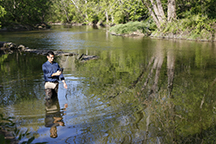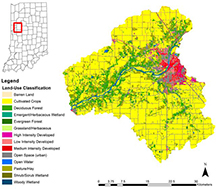June 1, 2016
Tapping citizen scientists to test water quality can yield valuable data
 Indrajeet Chaubey, a professor of ecohydrology, tests water quality in Wildcat Creek, a tributary of the Wabash River. (Purdue Agriculture/Tom Campbell)
Download image
Indrajeet Chaubey, a professor of ecohydrology, tests water quality in Wildcat Creek, a tributary of the Wabash River. (Purdue Agriculture/Tom Campbell)
Download image
WEST LAFAYETTE, Ind. - With a little training and simple equipment, members of the public can generate data that provides valuable insights into the health of local streams, a Purdue University study shows.
Twice a year, hundreds of volunteers participate in the Wabash Sampling Blitz, a water-quality monitoring program in central Indiana. Over four hours, they collect water samples from 206 sites within the region of the Great Bend of the Wabash River Watershed and assess the samples for temperature, pH, water cloudiness, levels of nutrient runoff and pathogen concentrations.
The Blitz proffers local watershed managers far more information about the water quality of the Wabash and its tributaries than they could gather on their own. But how valid is the data?
Purdue researchers found that Blitz volunteers proved consistently able to estimate nitrogen concentrations in the water with "moderate to substantial agreement to lab values," said Indrajeet Chaubey, principal author of the study and professor of ecohydrology.
 This graphic shows location and land use of the Great Bend of the Wabash River Watershed from the 2001 U.S. Geological Survey Land Cover Dataset. (Muenich et al.)
Download image
This graphic shows location and land use of the Great Bend of the Wabash River Watershed from the 2001 U.S. Geological Survey Land Cover Dataset. (Muenich et al.)
Download image
"Volunteers' analysis of nitrogen levels were directionally correct," he said. "When you hone in on exact numbers, the accuracy gets cloudier, but the values are generally true. This suggests that citizen scientists can provide meaningful and highly valuable data for watershed groups."
According to the U.S. Environmental Protection Agency, 52 percent of assessed streams in the U.S. have degraded water quality. Agricultural operations, in particular, can be sources of nitrogen, phosphorus and sediment, which can leach or drain off into waterways.
The majority of the land that drains to the Wabash River is used for row crop agriculture, and the watershed is also home to the urban areas of West Lafayette and Lafayette.
Monitoring water quality can be a complex and costly undertaking, and capturing a glimpse of the entire Wabash watershed was far beyond capability of the staff of the Wabash River Enhancement Corp., a nonprofit agency that leads efforts to improve the river and its tributaries.
In 2009, WREC, partnering with Purdue researchers, created the Wabash Sampling Blitz to recruit, train and deploy community volunteers in a large-scale, simultaneous data collection effort. Volunteers travel to assigned sites in the watershed where they measure water transparency and temperature in stream and collect and assess water samples using field test strips that change color according to nutrient and contaminant concentrations.
"The impetus of the Blitz was the question 'What does water quality for the whole watershed look like?' " said study co-author Ron Turco, professor of soil microbiology. "We'd never seen the entire watershed in a six-hour period. The Blitz accomplishes that goal completely."
The Blitz acts as a screening tool, revealing "hot spots" in the watershed that could need more attention and effort.
While volunteer-analyzed nitrogen values were on par with laboratory-analyzed values, the results for orthophosphates, another group of nutrients, were spottier. Chaubey attributed this to the limits of the field test strips.
"Orthophosphates are generally very low in rivers, and the test strips are made to test for higher concentrations," he said.
The researchers emphasized that the value of community science efforts goes far beyond the data. The Blitz also helps the public understand the link between what happens in the landscape and how it affects local waterways, Chaubey said.
"The Blitz requires a lot of time, effort and coordination, but the returns are tremendous: a snapshot of the entire watershed, increased awareness of water quality issues and the opportunity to bring science to citizens and educate them on what they can do to protect water quality," he said.
The study was published in the first edition of the journal Citizen Science on May 20 and is available at http://doi.org/10.5334/cstp.1.
The Wabash Sampling Blitz is funded by the Indiana Department of Environmental Management and Indiana American Water. For more information about the Blitz, visit www.wabashriver.net/wabash-sampling-blitz.
Writer: Natalie van Hoose, 765-496-2050, nvanhoos@purdue.edu
Sources: Indrajeet Chaubey, 765-494-5013, ichaubey@purdue.edu
Ron Turco, 765-494-8077, rturco@purdue.edu
ABSTRACT
The Wabash Sampling Blitz: A case study on the effectiveness of citizen science
Rebecca Logsdon Muenich 1*; Sara Peel 2; Laura C. Bowling 3; Megan Heller Haas 3; Ronald F. Turco 3; Jane R. Frankenberger 4; Indrajeet Chaubey 5
1 Graham Sustainability Institute, University of Michigan, Ann Arbor, Michigan, USA
2 Wabash River Enhancement Corporation, Lafayette, Indiana, USA
3 Department of Agronomy, Purdue University, West Lafayette, Indiana, USA
4 Department of Agricultural and Biological Engineering, Purdue University, West Lafayette, Indiana, USA
5 Department of Earth, Atmospheric, & Planetary Sciences and Department of Agricultural and Biological Engineering, Purdue University, West Lafayette, Indiana, USA
* Corresponding author
E-mail: rlogsdon@umich.edu
The increasing number of citizen science projects around the world brings the need to evaluate the effectiveness of these projects and to show the applicability of the data they collect. This research describes the Wabash River Sampling Blitz, a volunteer water-quality monitoring program in Central Indiana developed by the Wabash River Enhancement Corporation (WREC). Results indicate that field test strips for nitrate+nitrite-N read by volunteers generally agree with lab-determined values. Orthophosphate results are less transferable owing to low observed concentrations, although the field test strip values from unfiltered samples consistently over-predicted the lab values. Hierarchical cluster analysis (HCA) applied to volunteer-collected data groups sampling sites into meaningful management clusters that can help to identify water-quality priorities across the watershed as a proof of concept for watershed managers. Results of the HCA provide an opportunity for WREC to target future programs, education and activities by analyzing the data collected by citizen scientists. Overall this study demonstrates how citizen science water quality data can be validated and applied in subsequent watershed management strategies.
Agricultural Communications: (765) 494-2722;
Keith Robinson, robins89@purdue.edu
Agriculture News Page

